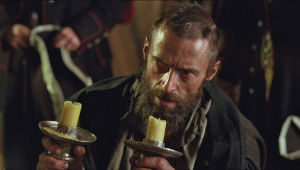A few years ago, at the family cabin, my wife chastised one of the kids for running past a wooden stake, topped with a pink ribbon.
“Get over here. The neighbors put up those stakes because they were tired of people going into their yard.”
This surprised me, as I knew my dad had surveyed the property in an effort to divide the lot. The stakes were commissioned by him, not the neighbor.
“Where’d you hear that?” I asked.
“Your mom.”
My mom hadn’t communicated with my dad about the survey. So my mom, in an effort to understand reality, assigned a narrative that made sense to her, along with a motive. She didn’t know about the stakes, so obviously it came from the neighbors who shared her border. But why would they do such a thing? Because they were sick and tired of her grandkids disturbing the pine needles on their property, obviously.
Had she just called the neighbors, or mentioned it to her husband, the miscommunication could have been avoided, instead the narrative she created was passed around to my wife, then my kids and i’m sure others in my extended family still think the neighbors are a bunch of pricks because of it.
Two parts in the example above, create and build tension.
- Using point of view, we can develop a perception of reality unique to our characters. The disparity between these perceptions are where we breed tension, with each character reacting according to their perception to a situation.
- Having our characters assign motive to others without understanding their perception of reality.
In Les Miserables, Fantine hates Jean Valjean because he fired her. He hadn’t, that was her perception. She was fired by a female supervisor who’d discovered her illegitimate child. The supervisor brought up the situation to Valjean, omitting some detail, and Valjean invited her to do what she thought best.
Later, after Fantine plummeted into poverty and sin, all for the noble cause of caring for her daughter, she confronts Valjean with anger, matching the hatred he must hold for her. Only, he doesn’t even know who she is and tries to help her as he would anyone in her situation. The tension explodes, becoming another inciting event for Valjean when he understands Fantine’s perception of reality, he’d fired her, his motive, he despised her for her sins. His perception of reality was quite different. Anyone could find redemption. She’d made a mistake and should hardly have to pay for it the rest of her life. In fact, God could use that mistake to bring about a wonderful miracle that was Cosette.
Later in the story of Valjean we find another miscommunication between Javert and Valjean. Javert expects to be shot for spying on the revolutionaries. Valjean volunteers to shoot Javert, not because he wanted to be free of the old prison guard, but because he wanted to save Javert’s life. This blew Javert’s mind and he vowed to continue to hunt Valjean down, which he does later, but when it comes time to arrest Valjean, his perception of reality has changed so drastically, he chooses to not live in his newfound reality and kills himself after letting Valjean go.
As a reader we can bask in the tension created by conflicting perceptions of realities from two or more characters that we’ve come to know through their point of views.
 I live in Arizona with my family, wife and five kids and a little dog. I write fiction, thrillers and soft sci-fi with a little short horror on the side. I hold an MBA and work in finance for a biotechnology firm.
I live in Arizona with my family, wife and five kids and a little dog. I write fiction, thrillers and soft sci-fi with a little short horror on the side. I hold an MBA and work in finance for a biotechnology firm.
I volunteer with the Boy Scouts, play and write music, and enjoy everything outdoors. I’m also a novice photographer.
You can read some of my works by visiting my Wattpad page and learn more at www.jacekillan.com.




